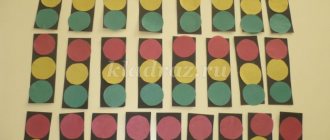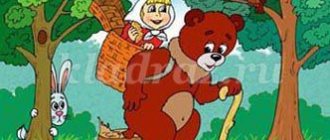Summary of GCD for FEMP in the middle group “Journey to the Land of Mathematics”
Category: Class notes Created: 11/21/2019
Teacher Anastasia Vadimovna Katueva
Goal: development of students’ mathematical abilities. Consolidating children's knowledge of quantitative and ordinal counting, the names of geometric shapes.
Tasks:
Educational:
- secure geometric shapes
- consolidate knowledge about numbers within 5;
- consolidate the ability to correlate numbers with the number of objects;
- improve counting skills
- strengthen children's ability to give complete answers
Educational:
- develop attention, logical thinking, speech, color perception, fine motor skills, perseverance, eye, memory.
Educational:
- cultivate the ability to listen to the opinions of others, listen carefully to the teacher’s questions and each other’s answers;
- develop the ability to work independently.
Integration of educational areas: “Cognitive development”, “Speech development”, “Physical development”, “Social and communicative”.
Educator:
Guys, this morning, when I came to work, I saw that there was a letter on my desk, but I decided not to open it and wait for you all to read it together.
Listen:
"Hello guys. The Queen of Mathematics is writing to you, I heard that you know numbers, geometric figures, and love to do mathematics. That's why I have prepared a gift for you - a surprise. But to get it, you need to travel and complete my tasks. If you are brave, determined, confident in your abilities, then hit the road. Bon Voyage".
Do you guys like math? Are you confident in your abilities and knowledge? Then let's go to the land of Mathematics!
Guys, do you like to travel? (children's answers)
And if you are very determined and brave, then I suggest you take a trip on an airplane carpet.
Educator: Oh, guys, our “airplane carpet” was gnawed by mice. We urgently need to fix the magic carpet. I have geometric shapes on my tray.
(Children take turns applying and identifying those “patches” that are suitable for repairing the carpet.)
Educator: What “patches” did you need to repair the rug?
Children: “Patches” in the shape of a square, rectangle, triangle, circle.
Educator: Our carpet is ready to fly.
Let's hold hands, sit on our airplane carpet and fly. Close your eyes. What do you imagine? (Sky clouds). What could be underneath us? (land, cars, houses, etc.)
Here is our carpet - the plane has arrived at the first station, it’s called the “Geometric Figures” station
"Geometric Figures" station.
Lay out the pattern according to the diagram (geometric shapes)
Educator: Well done! Now we will move on to the next station.
We arrived at the “number station”. Do you know the numbers? Can you count? We'll check this now.
- "Digital Station"
Correlate the figure with the number of items (stamps) according to Mate+ teaching materials
Physical exercise.
One - rise, stretch, (Stretched.) Two - bend, straighten, (Bent your backs, hands on the belt.) Three - clap your hands, three claps, (Clap your hands.) Three nods with your head. (Move your head.) At four - arms wider, (Arms to the sides.) Five - wave your arms, (Swing your arms.) And start counting again!
We are heading to the next station.
- "Bears on the Path"
(arrange the bears according to the diagram.) UMK Mate+
Educator: Well done guys! Look how many interesting tasks the Queen of Mathematics has prepared for us. Let us please her too and make some beads for her.
- “Beads for Queen Mathematics.
Repeat the pattern (chips) UMK Mate+
Educator: Our journey to the country of “Mathematics” has come to an end. Want to know what Queen Math has in store for you?
Let's go back to kindergarten! We sit down on our carpet. Let's fly!
— Tell me, what did you like most?
— What was the most difficult?
What was the easiest thing?
Where have we been and what have we done? (children’s answers, summing up the lesson)
This is where our journey ended. See you again!
- Back
- Forward
Preparing notes for a math lesson in the middle group of kindergarten
The duration of the lesson is 20 minutes, compared to the younger group, children complete a larger volume of tasks, and the overall pace of work noticeably accelerates. Classes are traditionally held once a week, but you should not limit yourself to the narrow time frame of long-term planning of educational activities. To reinforce program material, you can organize mathematical game situations during a walk or free play outside of class.
General recommendations:
- The teacher begins to study new material after repeating previously studied material. Repetition takes no more than five minutes and is carried out in a playful way, for example, “Help Pinocchio count the coins,” “Find the mistake with the Kid,” etc., as well as using thematic poems, riddles, and songs. Such exercises are aimed primarily at stimulating the natural resourcefulness and ingenuity of children, directing attention in the necessary creative direction, creating a positive emotional climate and a joyful mood, helping each child to reveal their intellectual capabilities;
- Children four to five years old find it difficult to cope with monotonous monotonous work, so it is advisable to carry out motor, finger or breathing exercises with little fidgets in time, and include active games of a mathematical nature in the process of work.
Forms of work and individual approach
The optimal option for organizing and conducting mathematics classes involves dividing children into pairs or small subgroups, taking into account different intellectual abilities. This will help improve the quality of education and create the necessary conditions for the implementation of an individual approach and rational dosing of mental and psychological stress, depending on the level of preparation of children.
The optimal option for organizing and conducting mathematics classes involves dividing children into small subgroups
You can individualize work with children in two directions:
- capable children who show a passion for mathematics can be given more complex tasks of a problematic nature;
- For children who experience difficulties in fulfilling program requirements for various reasons (the child has individual intellectual characteristics of perception or poor performance), it is more advisable to give simple tasks that they can solve. Such a differentiated approach will help maintain the child’s interest in mathematics, and gifted children will be able to more fully realize their mathematical abilities.
Practical methods and tools for educators
In the middle group, the volume of tasks gradually increases, which already includes two or three links, for example, children must count the bunnies in the picture and the same number of squares on the card.
Difficulties in working with children 4–5 years old:
- Children have difficulty maintaining attention while explaining a task, so it is important to teach them to listen to the information to the end and not allow them to start completing the task ahead of time. It is advisable that children begin to work together, without interfering with each other, adhering to the correct algorithm of actions;
- questions addressed to a specific child are answered in unison, shouting from their seats. The teacher’s task is to cultivate a friendly attitude towards each other, a desire to help a friend, but teach them to answer one at a time, pronouncing the words loudly and clearly.
Methodology for teaching quantity and ordinal counting within five
Stage one is a quantitative comparison of two groups of objects arranged in two horizontal parallel rows, which are located one below the other for greater clarity. Initially, groups consist of one and two or two and three objects, later moving on to more complex combinations of four and three, four and five objects. Differences (more, less, equal) are fixed by words denoting numerals, thanks to which children perceive the relationship between number and the number of objects. The teacher counts the objects of both groups (one has one more object), clarifies which objects are more and which are less, translates them into numerical ratios, and draws the children’s attention to the final result. The teacher quantitatively changes the composition of one of the groups, adding or subtracting one item, which helps to see and understand how the next or previous number can be obtained. Children are asked to show and name the number of objects, to say where there are more and where there are less, which helps to consolidate new number words in memory. Final skill: children must learn to distinguish the quantitative composition of a group of objects and answer the question “How much?”
The second stage is devoted to mastering the operations of ordinal counting and counting skills; children are taught to show feminine, masculine and neuter objects (doll, ball, apple) in order and name the corresponding numeral word. To develop and consolidate counting skills, a variety of game exercises are used, alternating collective and individual forms of work with visual aids. In the future, children train in the ability to count objects, independently select them into groups and place them in a specified place (shelf, table, chair). Then the kids are asked to form a quantitative group based on the named number, for example, “Collect 2 cubes and 4 balls.” At the same time, work is being done to develop spatial orientation skills: “Put it on the left, on the right, above, below. Stand in front, behind, etc.” In addition, it is important to pay attention to the development of the ability to determine the qualitative characteristics of objects, such as color, size, length, width, shape, and comparisons based on one of the properties.
Video: introducing the number and number three
Common children's words often use the word "one" instead of the numeral "one". The teacher shows the toy and asks the question: “How many cars do I have?” “One car,” the kid answers. Such a dialogue will help you remember the correct use of numeral words.
Comparing objects of different sizes: planning for teaching
A good eye is the key to the safety of children’s movement in space. A lot depends on how much a child is able to estimate the distance between objects in the world around them and their sizes. Much attention is paid to this aspect in preschool education. The chronological distribution of classes according to the annual schedule has its own characteristics.
- The first three months of the school year are devoted to training the ability to compare two objects (laces, scarves, toys, cardboard strips, construction kit parts, etc.) according to such parameters as height, length, width, thickness, volume. Techniques of superimposition, applications and comparisons by eye are used.
- In winter, children are taught to conduct a comparative analysis of two flat objects, considering their length and width, and pairs of objects that differ in either length or width are selected. When children confidently cope with the task of establishing relationships between two objects, they can safely expand the quantitative range to five and begin exercises related to arranging objects in a row according to the principle of increasing or decreasing according to a certain criterion.
- In the third quarter, special attention is paid to the development of children's eye. Children are asked to eyeball a larger or smaller object and are also taught to use a measuring stick. You can also ask children to estimate the distance between pieces of furniture by eye: what is further, what is closer, how many balls will fit between two chairs, etc.
Helpful advice: it is advisable to use a motor analyzer (the area of the brain responsible for tracking muscle activity and body position in space): invite children to “run their fingers” along the edges of objects, make movements with their fingers along, across, from bottom to top, determine which object the finger is running on longer. It is also important to train and develop mathematical skills in drawing, appliqué, and music classes.
Lesson plan
- Organizational introductory part (3-5 minutes) – a motivating start to the lesson.
- Practical - the teacher explains the essence of the tasks and exercises that children must cope with (3-5 minutes).
- The main one is children’s independent work (15 minutes).
- The final one is the analysis and assessment by children of the results of their work. Children are taught to formulate their point of view with reason and independently talk about the sequence of completing the task (3 minutes). Questions worth discussing:
- how successfully the task was completed;
- new techniques that the children were introduced to;
- causes of errors and ways to correct them.
It is also useful to think through weekly lesson plans for FEMP on different topics.





